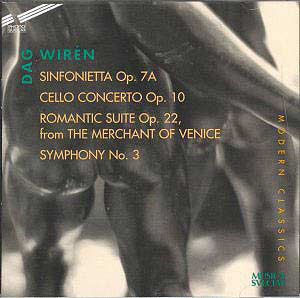Wirén's
musical articles of faith were firmly founded on 'Bach, Mozart,
Nielsen and absolute music'. So wrote the composer in 1945. This
however did not present an obstacle to writing music that many
listeners will associate with nature pictures such as the slowly
heaving sea-swell in the first two movements of the Sinfonietta.
Wirén's
most famous work is the Serenade for Strings (1937) from
three years after the Sinfonietta. The Serenade's active darting-chaffing
jerky-joky exuberance can also be heard in the Sinfonietta
(the two molto allegros). The middle movement surely reflects
the composer's experience of marine-scapes during his summer retreats
to his holiday home on the Stockholm archipelago. The Sinfonietta
is an adroitly balanced mix between play and poetry rather like
the Moeran Sinfonietta of ten years later. The composer's
only recording as conductor is of this work. It was issued in
1948 on Cupol 6013-4 and reissued on Phono Suecia PSCD 79 in 1995.
The
compact Cello Concerto is from the same year as the Serenade.
It is lively, personable and determined, exploring some sombre
realms along the way; sometimes with a distinctly Baxian leaning.
The chuckle and chatter of birdsong and of soloistic dialogue
can be heard as it is in the Sinfonietta. It was written, as were
so many of Wirén's cello works, for his friend since the
Parisian days, Gustav Gröndahl. Gröndahl premiered it
in Stockholm in 1939.
The
Merchant of Venice Suite or Romantic Suite is
from his 1943 incidental music for the play. It is in five movements,
the first, third and fifth of which have the slow-dripping melancholia
of Ma Mère l'Oye and of Nino Rota's romantic andante
mood. The darting second movement picks up on the theatre music
of his idol, Sibelius, while the fourth is rollickingly chipper,
along the lines of Pulcinella. This is lovely music, deeply
appealing in a wan Scandinavian way and making an intriguing cross-reference
with Nystroem's music for the same play.
The
Third Symphony was composed as the Second World War was
reaching its closing phase. It is dedicated to the composer's
parents and is somewhat redolent of the classical athletic Sibelius
in the Third and Sixth Symphonies. As with all his music the language
is tonal with chamoix smooth acerbities from Stravinsky. Listen
for the Sibelian modelling in the lively woodwind solos in the
first movement. After an almost morose adagio comes a shatteringly
active allegro molto with a rather pompous triumphant tone.
Wirén
wrote only 44 works and rather like Howard Ferguson simply stopped
composing in 1972. He would not say why.
Rob
Barnett
